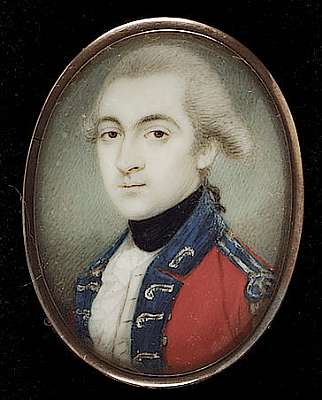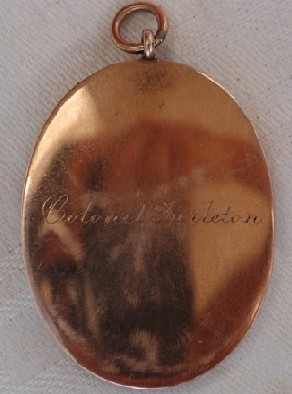


|

|
This miniature portrait is identified as Tarleton on circumstantial evidence. As you can see, the reverse is engraved "Colonel Turleton" -- which could be the result of a typo by the engraver (or simply a badly rendered "a"), a misreading of instructions or some similar source of error. There were no "Turleton"s in the army of the day, which rules out the most obvious source of misidentification. Since the identification gives the rank as "Colonel," it was presumably added to the case years or decades after the miniature was painted.

|

|
Christopher Bryant found the miniature in a collection assembled in the 1930s-40s. This collection was sold in its entirety at Bonhams in London in one of their recent portrait miniature sales. It was offered for sale by one of the children of the original collector.
The strongest evidence for identifying it as Tarleton comes from the uniform. Chris comments, "I am something of a uniform specialist, and was able to determine that the uniform depicted in the miniature is that of a Brigade Major of Cavalry. (The curled embroidered loops on the facings are peculiar to staff, and silver loops in pairs are for Brigade Majors -- those of infantry had the epaulette on the right, cavalry on the left.) The date of the hairstyle and uniform would be mid 1770's. All of this points to a positive identification of Banastre Tarleton. It would also suggest that the portrait was done in America, as he only became a brigade major after arrival and presumably relinquished that role upon taking the command of the British Legion in August of '78, if not earlier."
He also notes, "Another small point to make about the Turleton miniature in its defense are the similar specific features of brown eyes and a strong prominent nose. ... I see a strong resemblance ... between the depiction in this miniature and those in the 1799 engraving of General Tarleton and the watercolour portrait by his wife."
As with most miniatures of the time, the work is unsigned, but if the portrait was done while Tarleton was a brigade-major, the list of likely artists is certainly short. Chris comments, "The linear hatching of the background of the miniature, as well as the handling of the uniform and the pale features are finely executed, indicating that it was painted by a skilled miniaturist. There were relatively few painters living and working in either Philadelphia or New York during the period when this miniature was most likely painted; those known to have painted miniature portraits of British officers include Charles Willson Peale (1741-1827), James Peale (1749-1831), Pierre Eugene Du Simitiere (1737-1784), John Ramage (1748-1802) and possibly Matthew Pratt (1734-1804)."
Concerning the possibility that the artist is Charles Willson Peale, the most famous of those artists, Chris comments, "As for Peale painting British officers, I understand there has been another that surfaced in recent years attributed to CW Peale of an officer of the 17th Light Dragoons. Sellers in his book on Peale miniatures also includes one of a British officer who stayed in the Philadelphia area after the war. The circumstances after the war and the fact that the British officers who would presumably have been among his clients during or before the occupation of Philadelphia in September of 1777 otherwise all died or returned to Britain could account for the relative scarcity of other attributed examples."
[Images and background information kindly provided by Chris Bryant. ]
| Return to the Main Page | Last updated by the Webmaster on October 10, 2006 |